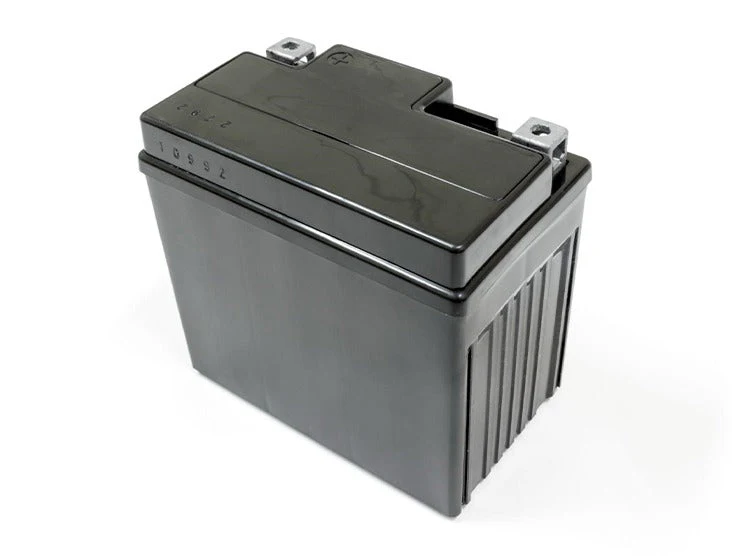The lead acid motorcycle battery is the most common battery type and was the first rechargeable battery ever created. Lead acid batteries are affordable but lack durability. They are unsuited for cold temperatures since the acid has a low freezing point. This article will discuss the basics of motorcycle lead batteries.
Table of Content
1. Motorcycle Lead Acid Battery
The motorcycle lead acid battery is based on seminal gravity-style batteries. This battery was the first commercial rechargeable battery invented in 1859 by French physician Gaston Planté. Despite their age, lead acid batteries are dependable, cheap, and can deliver an adequate power output.
Charging a lead-acid motorcycle battery is simple, but voltage limits must be followed. It is easy to charge a lead acid battery, but it takes between 14-16 hours to fully recharge. When in storage, the battery must have a full charge.
2. Motorcycle Lead Acid Battery Basics
2.1 Design of Lead Acid Motorcycle Battery
A lead acid motorcycle battery is constructed from a lead alloy with traces of selenium, tin, antimony, and calcium. Since pure lead is too soft to sustain itself, tiny amounts of other metals are mixed to increase mechanical strength and enhance electrical qualities. Antimony, calcium, tin, and selenium are the most common additions. These batteries are frequently referred to as "lead-antimony" and "lead calcium."
The battery’s frame has several individual cells linked to each other inside a large container. Voltage is produced by the interconnected cells channeling the power output.
Each cell is made up of clusters of lead plates that have a positive or negative charge. The positive charges come from lead dioxide plates, while the negative charges come from spongy lead plates. However, other lead-based compounds can be used depending on the quality of the battery. To keep them from making contact, the plates are arranged in an alternating pattern with paper or fiberglass insulation between them.
The positive and negative plates are only linked to other plates in the adjacent cells with a similar charge. The cumulative power output building up along the cells helps create the necessary voltage.
2.2 Types of Motorcycle Lead Acid Battery
There are three main types of lead acid motorcycle batteries:
- Absorbed Glass Mat (AGM) Battery
- Gel Battery
- Flooded Battery
Valve Regulated Lead Acid Batteries (VRLAs)
VRLAs, also known as sealed batteries, come in two types: absorbent glass mat (AGM) and gel batteries.
When a conventional battery is charged, the water inside the cells is broken down into hydrogen and oxygen. When gases build up pressure inside the battery, they eventually are released into the environment. As a result, the cells gradually lose water, requiring you to periodically refill the battery.
VRLA batteries have lead calcium alloy plates instead of the standard lead dioxide and spongy lead plates. These batteries do not create hydrogen while charging. Oxygen is still produced, but rather than being released, it combines with the active chemicals inside the battery to create water. To prevent the battery from overcharging due to excess oxygen being produced, there is a safety valve/flame arrestor you can activate.
Sealed batteries are more expensive than normal batteries due to having more features. Sealed batteries have a base price of almost twice what a standard battery would cost.
Absorbed Glass Mat (AGM) Battery
An absorbed glass mat or AGM battery is the most popular maintenance-free motorcycle battery.
In an AGM battery, an electrolyte is absorbed by the glass fiber mats that sit between cells. The mats prevent evaporation and do not require topping off. The electrolyte acts as a separator, allowing the plates to press together and increasing power output.
The AGM battery has a one-way valve to release gas to reduce pressure buildup in the casing when overcharged or drained. This characteristic is why AGM batteries are classified as VRLA batteries.
Another advantage of the mats is that it keeps the electrolyte in place and prevents it from dissipating which makes it possible to install this battery in a variety of configurations.
AGM batteries have shorter lifespans due to the higher acid content necessary to raise the standby voltage and decrease the rate of water loss.
Gel Battery
A gel battery, also known as a gel cell, is the other kind of VRLA battery. Sulfuric acid is combined with fumed silica to produce a rigid, gel-like substance. Since it does not require liquids to function, it does not need to be kept upright. It is built to reduce electrolyte evaporation, spillage, corrosion, and vibrations.
Flooded Battery
A flooded lead acid battery, also known as a wet battery, has its cells flooded with electrolytes. It must be checked and topped off as needed on a regular basis, especially in hot and humid climates.
If this battery becomes drained, the heavier acid molecules descend to the bottom, causing the electrolyte to stratify (separate into layers of water and acid). When the battery is active, most of the current will only travel around this location, causing the bottom of the plates to wear out.
Because the battery is full of liquid, it must be kept upright to prevent spillage. While they are rapidly being phased out in the production of OEM motorcycles, they are still easily accessible due to their low cost.
2.3 Battery Cycles
Starter Battery
Starter lead acid batteries turn on motorcycle motors but cannot handle deep discharges. They have several thin plates with a wide surface area and a high current output. Frequent deep discharges could cause power loss and premature failure due to the electrodes degrading.
Starter batteries are the same size as deep cycle batteries but are more lightweight due to their light and thin plates. These plates do not extend all the way to the bottom of the battery. Therefore, any worn material falling from the plates collects at the bottom of the cell. This may result in a loss in battery capacity and voltage.
Deep-Cycle Battery
Deep-cycle batteries do not deteriorate quickly and are suited for systems and vehicles that tend to drain batteries fast frequently, such as solar powered equipment, electric vehicles (forklifts, golf carts, electric motorcycles, and others), and generators that produce an uninterrupted power supply. These batteries feature thicker plates that have a lower peak current but can handle repeated discharges.
Some batteries are hybrids that combine features of starter and deep-cycle batteries. They tend to run out of power faster than automobile batteries but not as much as deep-cycle batteries. These types of batteries are also called "marine/motorhome" or "leisure" batteries.
2.4 Battery Safety
Lead acid motorcycle batteries can contain hazardous materials like corrosive sulphuric acid and explosive gasses. Follow these tips to help you safely handle lead acid batteries:
- Make sure there are no sparks, smoke, or open flames around the batteries. These batteries can release highly combustible hydrogen gas that could cause the battery box to explode.
- When charging standard batteries, unscrew the vent covers and allow airflow inside. Too much oxygen and hydrogen trapped inside the battery might cause it to combust.
- If the motorcycle battery becomes too hot, stop charging and wait until it cools before continuing. High temperatures could destroy the battery plates and cause the casing to crack.
- For standard batteries, remove the sealing cap from the vent elbow. This will help release excess gasses inside the battery and reduce the risk of the battery combusting if left on. The ventilation tube should never be clogged or damaged.
- Connect the battery charger leads to their corresponding points: +ve to +ve and -ve to -ve. Before connecting or detaching the leads, unplug or switch off the charger. This reduces the possibility of sparks flying.
- When handling a battery, always wear protective clothes, gloves, and eyewear.
- If any battery liquid has spilled out, clean it up immediately. To neutralize the battery acid, use baking soda and water.
- Make sure that your work area is well-lit and that the containers with acids are clearly marked.
Also Read: How to Charge a Motorcycle Battery
2.5 Maintenance of Lead Acid Motorcycle Battery
Check the Fluid Level: Check your lead acid battery at least once per month. There are lines that indicate the minimum and maximum fluid levels. If you want to fill the battery with distilled water, make sure to wear protective headgear and gloves while working in a well-ventilated place. To extend the life of your motorcycle battery, make sure to conduct regular maintenance checks throughout the year.
Clean the Battery: Wipe off any accumulated grime and debris on the battery. Use a battery cleaner and a brush to remove corrosion on the battery terminal. Then wipe the battery with a wet cloth and dry it with a clean cloth afterward. Make sure the vent caps on the battery are tight to prevent the cleaner from entering the battery. Once you have cleaned and dried the terminal, apply an anti-corrosion spray on the terminals to prevent future corrosion.
Charge the Battery: Connect your motorcycle to the battery charger before hitting the road. Connect the negative charger to the negative post and the positive charger to the positive post. Before disconnecting the leads, switch off and unplug the battery charger.
Store at Room Temperature: Remove your motorcycle battery and store it at room temperature to prevent it from cracking or freezing during the winter.
2.6 Last Words
Lead acid batteries are among the oldest motorcycle batteries. This conventional battery has electrodes made of lead alloy with sulphuric acid serving as an electrolyte. This battery category has two major types i.e., wet b (flooded battery) and valve-regulated lead acid batteries (Absorbed Glass Mat and Gel batteries). Despite their short lifespans, lead acid motorcycle batteries are still widely used due to their low cost and reduced energy consumption. If you want to improve your motorcycle’s aesthetics, you can add new Saddlebags, handlebars, fairings, seats, crash bars, luggage racks, and sissy bars.
























Leave a comment
All comments are moderated before being published.
This site is protected by hCaptcha and the hCaptcha Privacy Policy and Terms of Service apply.